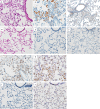Immunohistochemical characteristics of surfactant proteins a, B, C and d in inflammatory and tumorigenic lung lesions of f344 rats
- PMID: 25378802
- PMCID: PMC4217230
- DOI: 10.1293/tox.2014-0020
Immunohistochemical characteristics of surfactant proteins a, B, C and d in inflammatory and tumorigenic lung lesions of f344 rats
Erratum in
-
Errata (Printer's correction).J Toxicol Pathol. 2016 Jan;29(1):74. Epub 2016 Feb 17. J Toxicol Pathol. 2016. PMID: 26989306 Free PMC article.
Abstract
Surfactant proteins (SPs), originally known as human lung surfactants, are essential to respiratory structure and function. There are 4 subtypes, SP-A, SP-B, SP-C and SP-D, with SP-A and SP-D having immunological functions, and SP-B and SP-C having physicochemical properties that reduce the surface tension at biological interfaces. In this experiment, the expressions of SP-A, SP-B, SP-C and SP-D in lung neoplastic lesions induced by N-bis (2-hydroxypropyl) nitrosamine (DHPN) and inflammatory lesions due to quartz instillation were examined and compared immunohistochemically. Formalin fixed paraffin embedded (FFPE) lung samples featuring inflammation were obtained with a rat quartz instillation model, and neoplastic lesions, hyperplasias and adenomas, were obtained with the rat DHPN-induced lung carcinogenesis model. In the rat quartz instillation model, male 10-week old F344 rats were exposed by intratracheal instillation (IT) to quartz at a dose of 2 mg/rat suspended in saline (0.2 ml) on day 0, and sacrificed on day 28. Lung tumorigenesis in F344 male rats was initiated by DHPN in drinking water for 2 weeks, and the animals were then sacrificed in week 30. Lung proliferative lesions, hyperplasias and adenomas, were observed with DHPN, and inflammation was observed with quartz. The expressions of SP-A, SP-B, SP-C and SP-D were examined immunohistochemically. SP-B and SP-C showed strong expression in lung hyperplasias and adenomas, while SP-A and SP-D were observed in mucus or exudates in inflammatory alveoli. These results suggest the possibility that SP-B and SP-C are related to lung tumorigenesis.
Keywords: DHPN; lung; quartz; rat; tumor; urfactant protein.
Conflict of interest statement
Figures



References
-
- Pérez-Gil J, and Keough KM. Interfacial properties of surfactant proteins. Biochim Biophys Acta. 1408: 203–217. 1998. - PubMed
-
- Archer F, Jacquier E, Lyon M, Chastang J, Cottin V, Mornex JF, and Leroux C. Alveolar type II cells isolated from pulmonary adenocarcinoma: a model for JSRV expression in vitro. Am J Respir Cell Mol Biol. 36: 534–540. 2007. - PubMed
-
- Perez-Gil J, and Weaver TE. Pulmonary surfactant pathophysiology: current models and open questions. Physiology (Bethesda). 25: 132–141. 2010. - PubMed
LinkOut - more resources
Full Text Sources
Other Literature Sources
Miscellaneous
